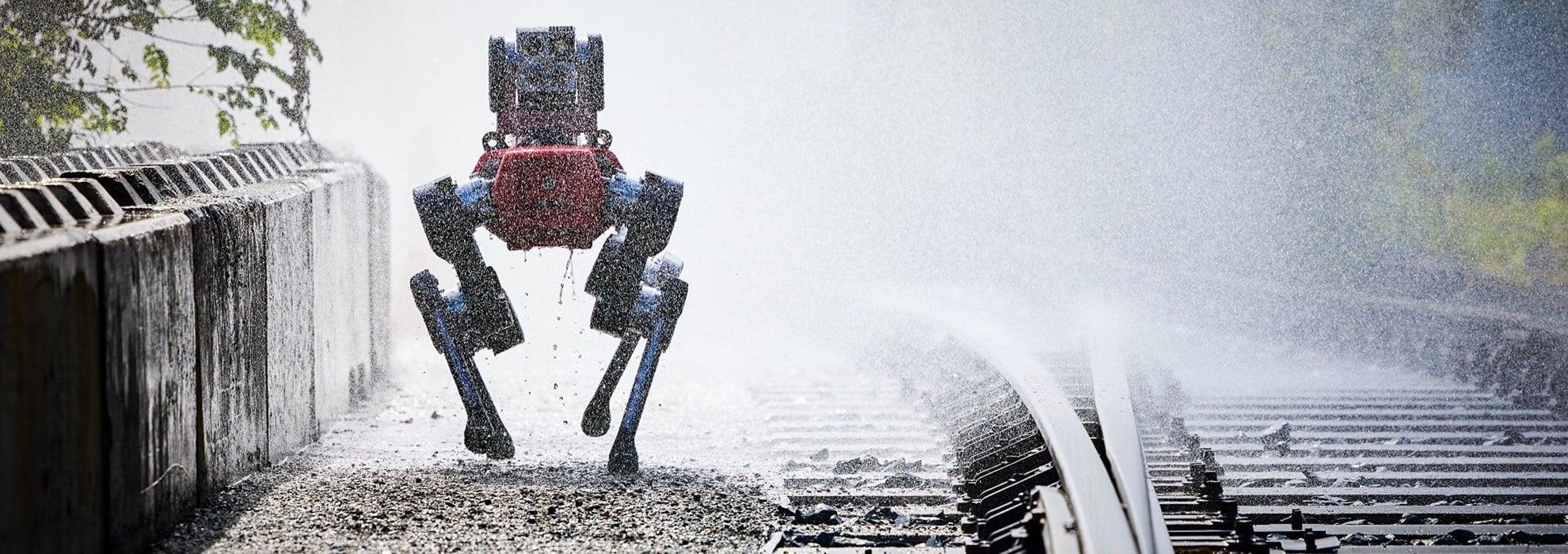In just a few more years, then we will maintain our tracks together with robots.
-Michiel Stam project leader at ProRail
Data collector
So what are we waiting for? Send that little dog on the tracks! “Well,” notes Stam. “If I send this robot on an autonomous mission now, it will carry it out, but if there is an obstacle somewhere, it might run onto the track. Also, the navigation of autonomous robots is not yet at such a level that they are guaranteed to stay out of the track or so-called profile-free space. Now they still sometimes want to ‘drift’ or stray from the programmed routes. These are things that will be further developed. And remember: a human can assess situations, think creatively, and a robot cannot do that at all yet.”
In the near future, autonomous robotics seems especially suitable for fairly simple, repetitive tasks, predicts Stam. Robots such as SPOT and ANYmalD could first be used as data collectors. To collect and transmit information about points, track geometry and other track components and objects in the surroundings. Data analysis is then done by back office data analysts or algorithms.
One advantage of non-rail-bound robots is that they do not necessarily have to ‘enter’ the track, with all that entails, but can get very close. “That makes the quality of the surveys and inspections high. Especially in rail yards, not being rail-bound is an advantage. Just to name a few: rail yards then don’t have to be ‘empty’ or emptied in order to be able to do the surveys and inspections.”
The robot must be able to manoeuvre on different types of terrain, without running into the track

Safety
But the technology is not that far yet. Stam: “We need to move towards robots that are programmed to carry out an assignment as well as being autonomous enough to dodge a rock, for example, without becoming a danger to themselves and others.” To this end, ProRail is now busy experimenting. We set up a 70-metre-long test track at the Kijfhoek railway yard. There, we are not only testing what robots can do on the track, but especially whether they can already do it safely and what is needed to make it formally safe.
Not new
Robotics still sounds futuristic. But it isn’t. “Robots are already very old,” adds Stam. “Think of the robots we know from the automotive industry”. But autonomous robotics does represent a relatively new development, fuelled mainly by developments with self-driving cars. If you walk through a shopping mall now, chances are you will come across an autonomous cleaning robot, which stops as you walk by. Stam: “Nobody is surprised by that. In industry, ports for example, people have also been incorporating autonomous robots for a long time. They can perform inspection tasks, which saves transport movements, manpower and reduces risks for people. So robotics is far from new, but the application for the rail industry is.”
Rules for people
In at least another three years or so, Stam estimates, then ProRail will hire its first robot. Before then, it must learn to operate safely, become somewhat cheaper and the regulations must be robot-proof. You don’t often think about it, but the regulations surrounding the railways are incredibly people-oriented. Which makes railways safe for people. “It may sound crazy, but whether that same level of safety should also apply to robots is an interesting question,” Stam explains. “Robots, by their nature, also bring new safety measures that we had never thought of before. Perhaps we will get new forms of cooperation: like a robot that may want to cross a track and can then contact a dispatcher to ask if that is OK. So the train dispatcher will soon receive a message from the robot. That’s a very different form of cooperation.”
Twenty years from now
In twenty years? Stam is willing to fantasise about that: “Then there will be robots walking around at railway yards like Kijfhoek, at least keeping an automated eye on the rail infrastructure. People would then only be needed for actions that the robot cannot do: welding, manipulation, heavy operations and the back office. Data collection is much heftier and robotic systems work together with drones. Perhaps they also talk to (automatic) trains: may I cross the track? A kind of robot ecosystem. Then people can start doing other things.”
